Agricultural and Biological Research
RNI # 24/103/2012-R1
Research - (2024) Volume 40, Issue 2
Iron toxicity and rice blast have been observed in the major tropical lowland and irrigated schemes. The objective of this study was to select new resistant/tolerant genotypes of rice to increase the varietal range. A trial was conducted in two (02) areas. An area without iron toxicity (Stox) and an area with iron toxicity (Tox). The plant material comprised of 64 genotypes of rice. The 64 genotypes were tested with several types of phosphate fertilizers in a split-splot experimental design with three (03) replications. The results showed that the triple super phosphate and the calcined phosphate were the best phosphate fertilizers in the management of iron toxicity and rice blasts. Rock phosphate is average efficient in the management of these two (02) physiological stresses. The genotypes (HB 46, HB62, KBR 2, KBR4, KBR 6, KBR 8, accession 68 and FKR 76) had the best yield compared to the controls Orylux 6 (FKR 84), Azucena in the TSP treatment. The accession 15, accession 225, accession 262, accession 270, accession 68 had the best yield in the calcined rock phosphate treatments. In all treatments, genotypes accession 225, CC 109 A, FKR 76, HB 46 and HB 62 had better yield and lower iron toxicity and rice blast scores.
Rice; Genotypes; Phosphate fertilizers; Iron toxicity
Rice is the fourth cultivated cereal (after millet, sorghum and maize) in both areas and production in Burkina Faso [1]. However, less than 49% of rice needs are covered by the national production despite rice importance as a foodstuff. In Burkina Faso, the irrigated rice cultivation systems with total control of water and lowland rice cultivation occupy 23% and 67% of the rice cultivation area in the country [2]. Those two types of rice production systems are hampered by several biotic (insect attack, rice blast, etc.) and abiotic (drought, physiological disorders, toxicity, etc.) constraints [3]. Iron Toxicity (IT) case was reported in Sri Lanka, India, Vietnam, Malaysia, the Philippines, West Africa, Brazil, Colombia and Madagascar [4]. This rice intoxication by iron is manifested by slowing down plants’ growth, reducing tillering and causing an important yield loss ranging from 10% to 100% [5]. However, this stress does not occur only by an important consecutive absorption of ferrous iron contained in the soil, but it is more linked to some unbalanced nutrition which is principally due to a low availability of Phosphor (P), Potassium (K), Silicon (Si), etc [5,6].
Some important areas were abandoned in the Kou Valley and N’Dorola (Region of Hauts-Bassins) and more than 300 households are threatened due to this rice intoxication issue [3]. Moreover, it caused a rise in rice farming expenses to more than 50% (additional facilities, chemical and organic fertilizers purchasing, etc.) for “resilient” rice farmers. To face this issue which is worsened by climate varying conditions, several agricultural practices have been proposed. Although, one of those practices had not been able, to solve, alone and efficiently iron toxicity until now. Any technique could not match unless the main responsible mechanism has been set clearly. This study aimed to assess rice’s genotype tolerance to iron toxicity and rice blast treated using local phosphate fertilizers.
Study area
The study was conducted in a rice farming perimeter located in the Kou Valley which is around 30 km from Bobo Dioulasso on the road Bobo Dioulasso-Faramana-Mali border. Its geographical coordinates are 11°22’ on the North latitude and 04°22’ on the West longitude with an altitude of 300 m. This irrigated perimeter which covers an area of 1260 hectares is a favorite area of iron toxicity [7]. The total water quantity registered during the 2020 and 2021 years are 1,130.3 and 1,083.3 mm in 68 and 67 days respectively. The soils with a low texture gather the sandy-argillaceous-silty soils and cover 66% of the perimeter. Soils with heavy texture cover 34% of the perimeter and gather the argillaceous and argillaceous-silty soils. Soil pH is 5.3. The types of soils are mineral hydromorphic to soils subjected almost permanently to an excess of water on varied texture materials. The degradation of the perimeter leveling in the Kou Valley after its setting, contributed to the high rise of the rate of ferrous iron. Soil analysis revealed that the Kou Valley site is toxic in iron with values ranging from 14,400-15,675 mg/kg at the horizon 0-20 cm and 20-40 cm respectively [3].
Plant material
The plant material used during rainy the season of 2020 included 64 genotypes:
• 30 genotypes (chosen among 288 accessions assessed in pots with local phosphate fertilizers during the rainy season of 2019 at Farako-Bâ station).
• 30 genotypes of Oryza Glaberrima Steud. specie from INERA/Farako-Bâ rice germplasm;
• 4 varieties were used as control (Table 1). These varieties are chosen for their different sensitivity to iron toxicity.
| Genotype | Specie | Nature | Height (cm) | Cycle (days) | 1000 grains weight (g) | Potential yield (kg/ha) |
|---|---|---|---|---|---|---|
| Azucena | Interspecific | Tolerant to iron toxicity and rice blast | 145-150 | 130 à 150 | 30 | 4000 à 6000 |
| ORULYX 6 (FKR84) | Interspecific | Tolerant to iron | 95-105 | 90-105 | 19,5 | 6500 |
| BOUAKE 189 | O. sativa | Susceptible variety | 69-105 | 120-125 | 28,1 | 5000 |
| IR64 | O. sativa | Susceptible variety | 100-110 | 105-110 | 26 | 6000 |
Note: FKR=Farako-Bâ Riz; O.=Oryza.
Table 1: Rice genotypes (4) used as checks during the rainy season 2020.
The plant material used during rainy the season of 2021 year was:
• 10 genotypes chosen during the field evaluation in the rainy season of 2020,
• 4 new genotypes named KBR (KamBoin Riz) (KBR 2, KBR 4, KBR 6 et KBR 8),
• 4 checks (Table 2). These checks are chosen based on their different sensitivity to iron toxicity.
| Order N° | Tolerant accessions with a good yield | Sensitive accessions | |
|---|---|---|---|
| Genotypes | 1 | Acc_225 | Acc 15 |
| 2 | CC109A | Acc 68 | |
| 3 | FKR76 | Acc 262 | |
| 4 | HB46 | Acc 270 | |
| 5 | HB62 | FKR56N | |
| Test control | Resistant/Tolerant | Sensitive | |
| 1 | Azucena | IR 64 | |
| 2 | Orylux 6 | Bouaké 189 |
Note: FKR=Farako-Bâ Riz; HB=Hauts–Bassins; CC=Cascades; Acc.=Accession.
Table 2: Rice genotypes (10) and checks (4) used in the rainy season 2021.
Fertilizers
During the rainy season of 2020, the fertilizer NPK (14-23-14) (T1) (positive control), the fertilizer Nitrate of Potassium (NK) (T2) (negative control), (90 kg/ha of dose) and the raw Rock Phosphate (P/PR) (T3) (135 kg/ha of dose) were entirely coated in the soil as manure before transplanting. The nitrogen (urea) (100 kg/ha) was brought to plants during tillering and heading steps at the doses of 1/3 and 2/3 of the whole dose respectively. Nitrate of potassium was added to the treatments T2 and T3 (Table 3) to alleviate the potassium and nitrogen deficiency effect in these treatments.
| Treatments | Fertilizers’ compounds | Coated quantity (kg/hectare) | Coated quantity (g/m²) |
|---|---|---|---|
| T1 | NPK | 200 | 20 |
| N (Urea) (45%) | 90 | 9 | |
| T2 | NK (Nitrate of Potassium) | 60 | 6 |
| N (Urea) (45%) | 90 | 9 | |
| T3 | Raw rock Phosphate (P/PR) | 135 | 13.5 |
| K2O (KCl) | 60 | 6 | |
| N (Urea) (45%) | 90 | 9 |
Note: T=Fertilizer’s treatment; N=Nitrogen, K=Potassium; P=Phosphor; g=Gram; kg=Kilogram; NPK=Nitrogen-Phosphore-Potassium.
Table 3: Treatments used in both trials: areas without iron toxicity (Stox) and areas with iron toxicity (Tox) in the Kou Valley during the year 2020.
During the rainy season of 2021, six fertilizer treatments were assessed:
1. NPK (positive control) (200 kg/acre), so a dose of 20 g/m²;
2. NK (negative control) 90 kg/acre (N), so a dose of 9 g/m²;
3. Rock phosphate (PR), 135 kg/acre of phosphor (P2O5) P(PR), so a dose of 13.5 g/m² of phosphor P2O5 (PR);
4. Triple Super phosphate (TSP) at 46 % of P2O5, 300 kg/acre, so a dose of 30 g/m²;
5. Calcined phosphate (135 kg/acre, so a dose of 13.5 g/m²);
6. Acidulated rock phosphate (105 kg/acre, then a dose of 10.5 g/m²)
Experimental design and assay maintaining
Trials were set through a split-plot design (Figure 1) in two areas of the Kou Valley’s site (Burkina Faso). An iron toxicity area (Tox) and a test control area that does not have iron toxicity (Stox). Two factors were studied in both assays. The main factor was phosphate fertilizers and the second one was rice genotypes. In the rainy season of 2020, 576 units of plots (64 genotypes X3 types of fertilizer X3 repetitions) and 324 units of plots (18 genotypes X6 treatments X3 repetitions) were studied.
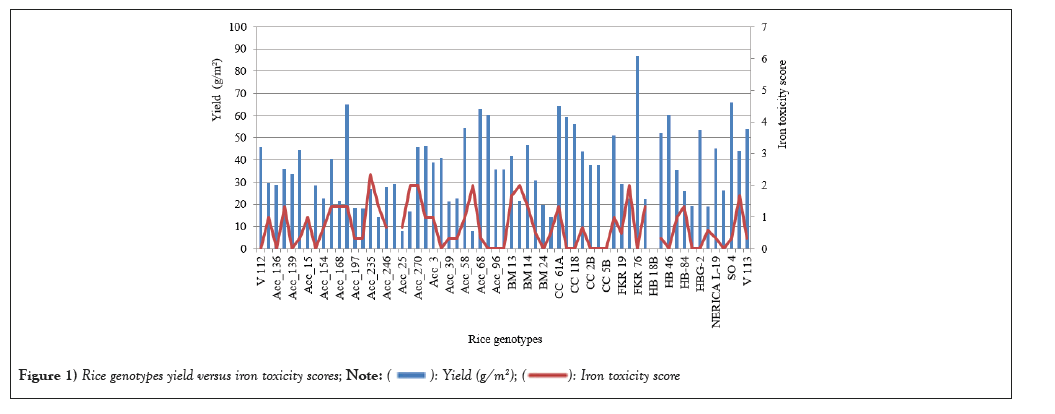
Figure 1: Rice genotypes yield versus iron toxicity scores; 
Both trials were set by plowing the ground, breaking mud balls and leveling the soil’s surface with a tractor. The elementary plots (1 m²) were delimitated with wooden pickets and identified by a label. Distances between plots in a treatment; between fertilizers’ treatment (sub-blocs) and between repetitions (blocs) are 0.5 m, 1 m and 1 m, respectively. Blocs and sub-blocs are set perpendicularly to the fertility gradient. Transplanting was done by keeping the dimensions of 0.20 m × 0.20 m between both lines and rows. An elementary plot has 25 plants.
Data collection concerned Iron Toxicity Scores (ITS) on rice plants. It consisted of appreciating, by sight, the iron toxicity on rice plants in the whole elementary plot, by using the rice standard evaluation system’s scale of 0-9 of the International Rice Research Institute (IRRI, 2002). On this scale, a score of 1 is equal to no iron toxicity symptoms and a score of 9 means extreme iron toxicity sensitivity (Table 4). Rice genotypes having the following scores: a score of 0-1; a score of 3-5 and the score of 7-9 are considered resistant, tolerant and susceptible, respectively [7,8].
| Scale | Description (Plant damage) |
|---|---|
| 0 | Growth and tillering are nearly normal |
| 1 | Growth and tillering nearly normal; reddish-brown spots or orange discoloration on tips of older leaves |
| 3 | Growth and tillering are nearly normal; older leaves are reddish-brown, purple or orange-yellow |
| 5 | Growth and tillering retarded; many leaves are discolored |
| 7 | Growth and tillering cease; most leaves are discolored or dead |
| 9 | Almost all plants are dead or dying |
Table 4: International Rice Research Institute’s scale (2002) for the description of iron toxicity symptoms in the field (damages on rice plants in the field).
Moreover, rice blast harshness was also assessed through eye observation by using the standard scale of IRRI (2002). This disease of rice provokes some long or oval lesions on leaves with/without a brown border. It was regularly evaluated by sight appreciation. The IRRI (2002) scale (0-9) on biotic stress notation was used to estimate rice blast incidence on the 35th, 42nd, and 56th day after sowing (Table 5).
| Score | Description |
|---|---|
| 0 | Any observed lesion |
| 1 | Lesions on the leaf’s inner surface at 5% (<5%) |
| 3 | Lesions’ incidence on the leaf’s surface range between 5 and 25% (5-25%) |
| 5 | Lesions’ incidence on the leaf’s surface range between 26 et 50% (26-50%) |
| 7 | Lesions’ incidence on the leaf’s surface range between 51 et 75% (51-75%) |
| 9 | Lesions’ incidence on the leaf’s surface ranges between 76 et 100% (76-100%) |
Table 5: International Rice Research Institute’s scale (2002) for the description of blast lesions on rice leaves (damages on rice plants in the field).
Data analysis
GenStat Release 12.1 software was used for the analysis of variance. For means Separation, the Newman-Keuls (SNK) test was used at the 5% threshold.
Grain yields of each treatment with and without iron toxicity
Iron toxicity and rice blast cause poor productivity of the rice genotype. Table 6 shows the results of the treatment’s yield comparison and iron toxicity symptoms in both study areas. The Analysis of Variance (ANOVA) is significant (P=0.017) in the iron toxicity (Tox) area whereas it is not significant (P=0.887) in the area without iron toxicity (Stox). In the area without iron toxicity, the yields (kg/m²) were 1.05 kg/m²in NPK treatment, 0.96 kg/m²in NK treatment, and 1.06 kg/m² in rock phosphate treatment. In the iron toxicity area treatment, T2 (NK) has a higher yield (0.272 kg/m²) compared to T1 0.245 kg/m²of NPK and T3 0.188kg/m²ok P/PR. Concerning the iron toxicity in STox (control area), none of the varieties had shown iron toxicity symptoms. In contrast, in Tox (favorite area for iron toxicity) the ANOVA is highly significant (P=0.005) and significant (P=0.038) respectively at 105 and 42 Days After Transplanting (DAT). At 42 DAT, genotype at treatments T1 and T3 had on tips of older leaves with reddish-brown spots or orange discoloration. However, with the treatment T2 all the rice accessions scored 0 as iron toxicity score. At 105 DAT the data obtained reveal that the genotypes in T1 and T3 were stunting and low tillering and many leaves showed discoloration. Genotypes at treatment T2 presented similar characteristics to the treatments T1 and T3 at 42th DA. Based on the iron toxicity scores performed by the genotypes, accession 225, CC109A, FKR76, HB46 and HB62 had lower iron toxicity scores. However, rice genotypes accession 15, accession 68, accession 262, accession 270 and FKR56N presented high iron toxicity scores (Figure 1).
| Treatment | STox | Tox | Yield difference | ||||
|---|---|---|---|---|---|---|---|
| Yield (kg/m²) | Iron toxicity | Yield (kg/m²) | Iron toxicity | ||||
| 42nd | 105th | 42nd | 105th | Stox-Tox (kg/m²) | |||
| T1 (NPK) | 1.29 | 0 | 0 | 0.245 ab | 1:00 AM | 5 b | 1.05 |
| T2 (NK) | 1.23 | 0 | 0 | 0.272 b | 0 ab | 3:00 AM | 0.96 |
| T3 (P/PR) | 1.25 | 0 | 0 | 0.188 a | 1:00 AM | 5 b | 1.06 |
| Source of variation | Fpr. | Fpr. | Fpr. | Fpr. | Fpr. | Fpr. | |
| Probability | 0.887 | 0.017 | 0.038 | 0.005 | |||
| Signification | NS | S | S | HS | |||
Note: T=Treatment; Stox=Area without iron toxicity; Tox=Area with iron toxicity; NS=None Significant; S=Significant; HS=Highly Significant. In each column, different letters mean significant differences (p<0.05); NPK: Nitrogen-Phosphore-Potassium; NK: Nitrate of Potassium; P/PR: Rock Phosphate.
Table 6: Comparison of yields and iron toxicity symptoms of fertilizers’ treatment according to the study area (area with and without iron toxicity).
Leaf blast’ manifestation in both study areas with each fertilizer’s treatment
The assessment of rice blast incidence on rice genotypes in the three treatments in both study areas (area with (Tox) and without iron toxicity (Stox)) is shown in Figure 2. The degrees of incidence differed according to areas (Stox et Tox) and the Days After Sowing (DAS). The symptoms of rice blast remained higher after the 56th DAS in the area with iron toxicity (Tox), but in the area without iron toxicity (Stox) the symptoms stopped at the 42nd DAS. In each area, leaf blast’s symptoms were more important with the treatment T1 (NPK) and less with T2 (NK). The genotype number 140, in area without iron toxicity had is growth and tillering retarded and had many leaves’s are discolored in the NPK (T1) treatment at 42nd DAS. In the area, of Tox, 28 genotypes had a score of 5 at 35th DAS with the treatment NPK (T1) and 6 genotypes had a score of 5 with the treatment NK (T2) (Table 5).
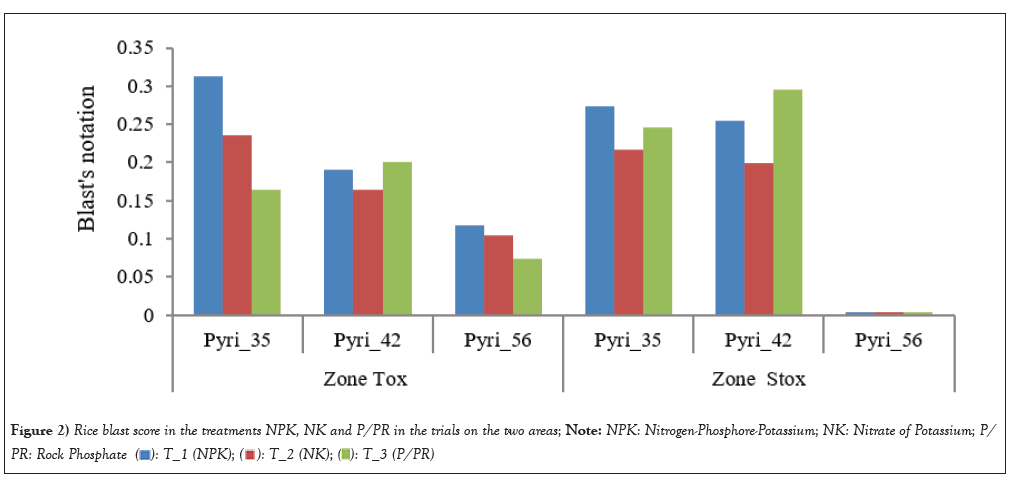
Figure 2: Rice blast score in the treatments NPK, NK and P/PR in the trials on the two areas; Note: NPK: Nitrogen-Phosphore-Potassium; NK: Nitrate of Potassium; P/
PR: Rock Phosphate 
Selected rice genotypes tested with phosphate fertilizers for improving tolerance to iron stress
Interaction between iron toxicity score and yield of rice genotypes on the two best fertilizer treatments:The analysis of each treatment contribution for iron toxicity reduction during the trials shows the following classification. According to the iron toxicity score reduction: The best two treatments in the process of the reduction or iron toxicity’s effects are the triple super phosphate (T4) and calcinated rock phosphate (T5). The triple super phosphate (T4)>calcined rock phosphate (T5)>rock phosphate (T3)>nitrate of potassium (T2)>Nitrogen-Phosphore-Potassium (NPK) (T1)>acidulated rock phosphate (T6). In the Triple Super Phosphate treatment (T4) (TSP), twelve (12) rice genotypes had a yield superior to the control variety Orylux 6 (546.42 g/m²) of iron toxicity (Figure 3) with a score of 2. Seven (07) genotypes had a yield superior to the tolerant control Azucena (642.31 g/m², with a score of 3). Figure 3, in the treatment, T5 (calcinated rock phosphate), the yield of all rice genotypes is superior to the control tolerant variety Orylux 6 (290.6 g/m²) with a score of 1 (Figure 4). Moreover, five (5) genotypes (accession 15, accession 225, accession 262, accession 270 and accession 68) had a high yield compared to the control tolerant variety Azucena (840.9 g/m² with a score of 2).
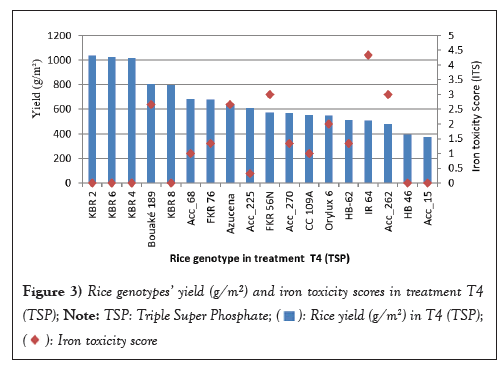
Figure 3: Rice genotypes’ yield (g/m²) and iron toxicity scores in treatment T4
(TSP); Note: TSP: Triple Super Phosphate; 

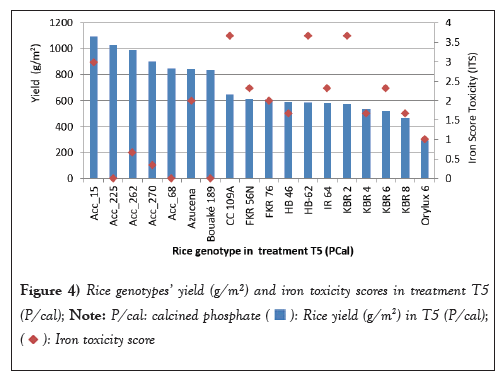
Figure 4: Rice genotypes’ yield (g/m²) and iron toxicity scores in treatment T5
(P/cal); Note: P/cal: calcined phosphate 

Diagram of Iron Toxicity Scores (ITS) and curves of leaf blast’s notes on different dates: Figure 5, showed a relationship between the iron toxicity score and rice blast score in the Burkina phosphate’s fertilizers treatment. Hence, at 53rd DAS, the lowest ITS was observed at treatment T4 (TSP) and T6 (acidulated rock phosphate). At 95th and 126th DAS the lowest ITS was observed at treatment T4 (TSP) and T5 (calcinated phosphate). The curves of the rice blast’s notes showed the treatment T4 (TSP) at the bottom level and T1 (NPK) at the top level at 35 DAS. For the rice blast symptoms effects, at 42 DAS, the lowest score is from T2 (NK) and T6 (P/Aci); and the highest score is from T3 (P/PR). At 56 DAS, the lowest rice blast harshness is occupied by the treatment T6 (P/Aci) and T2 (NK) the highest one.
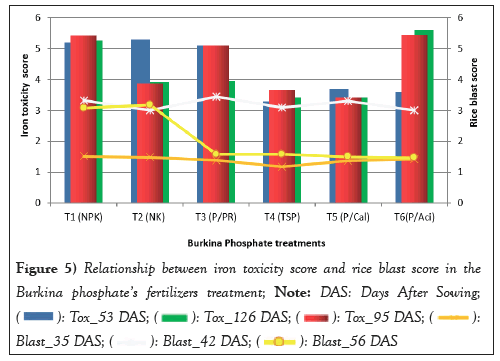
Figure 5: Relationship between iron toxicity score and rice blast score in the
Burkina phosphate’s fertilizers treatment; Note: DAS: Days After Sowing; 

The disparity of yields and the iron toxicity symptoms between the two areas of study could be explained by the nutritional state of the area. An area with no major constraint (an area without iron toxicity), a pH slightly acid (pH=5, 59), a good drainage, and good microbiologic activity, could create good nutritional conditions for plants. Symptoms expression is the principal communication means of plants when they face physiological stress [9]. These conditions influence positively the absorption and retention of nutritive elements, then their improvement of plant growth and root development. Audebert, et al., [3], Cherif, et al., [5] showed that, after the engorgement of the rice field, an anaerobic medium; added to the growth of the acidity (medium with iron toxicity), the iron reduction by microbes became intense, leading to a nutritional disorder for rice plants. The Ferrous iron (Fe2+) is massively absorbed by the major elements such as nitrogen, phosphorus and potassium [10, 11]. In the iron toxicity area, yields improved with NK (272 g/m²)>NPK (245 g/m²)>raw rock phosphate (188 g/m²). Rice field areas with strong agricultural activities and exclusive and continuous use of chemical fertilizers as NPK fertilizer. Hodomihou [11] revealed that those practices lead to soil acidification, its impoverishment in oligo-elements, and in a short time the reduction of production. In some cases, a diminution of the storerooms of microelements like zinc, boron, iron and sulfur, can even be observed just with enough coating of NPK fertilizer [12]. That could explain the performed by the nitrate of potassium with the means iron toxicity scores of zero (42 DAS) and 3 (105 DAS). The phosphorus (90 to 95%) absorbed by plants in the rice field may come from the fertilizers brought during farming [13]. When plants absorb phosphoric ions and then reduce this phosphoric concentration, the soil colloids release, a part of its phosphoric ions absorbed on the ground surface, in the soil solution to reestablish the balance. This could justify the low yield performed by the raw rock phosphate. However, rice genotypes CC 109A, HB46 HG62 and FKR 76 selected are traditional genotypes of O. Glaberrima Steu, inherited the best performance from their parents, which have great abilities to adapt and had good yield in tropical and stress areas. That would explain their performance as a good resistance to iron toxicity with the best yield. Further, the persistence of rice blast symptoms after the 56th DAS in the iron toxicity area could reveal that, both physiological constraints (iron toxicity and leaf blast) weaken simultaneously rice plants. In fact, according to the development step of plants, both constraints could be maintained or worsened, mainly by a nutritional deficiency of phosphorus and potassium. So, the coating of raw rock phosphate in the field permitted to reduce significantly the number of sensitive rice genotypes in treatment rock phosphate in comparison to T1 (NPK).
Moreover, the sensitivity of a genotype depends on its genetic status regarding the constraint, the assessment period and to the nutritional state of the soil determined by the fertilizer used. Rice genotypes IR64 (treatment NPK), FKR56N (treatment Rock phosphate), IR64, Azucena (treatment TSP) and Azucena, FKR56N, IR64 (treatment acidulated phosphate) had an iron toxicity score greater than 5. At 126 DAS, the rice genotypes Azucena (NK), FKR56N (rock phosphate), Azucena, Bouaké 189 and FKR56N (acidulated phosphate) registered an iron toxicity score greater than 5. These results of the variation of the symptoms of ferrous stress according to the treatments could be explained by the ability of rice genotypes to absorb and use the phosphorus from the soil solution to face the iron toxicity threat. There, comes the importance of the genetic variability for rice genotypes to absorb the phosphorus in its different forms. The indica group rice as Bouaké 189 and IR64 and New Rice for Africa (NERICA) L group as FKR 56N, japonica group as Azucena, are characterized by a strong tillering, the best vegetative development and the best yield of grains. Nevertheless, it seems to be less able to absorb the soluble phosphorus to face iron toxicity stress. Segda [14], shown that the score of leaf blast’s symptoms of the cultivars is easy to use and is the second factor, after the yield, in selecting a good vegetal material in iron toxicity conditions.
Although coating some phosphate (mono, binary or composed, etc.) fertilizers (triple super phosphate, calcined rock phosphate) could improve rice plant ability to face iron toxicity stress, according to the efficiency level, the abilities could be the retention and the oxidation of ferrous iron by the roots, etc [15,16]. It is the case with the calcined phosphate (P/cal), the Triple Super Phosphate (TSP), moderately with Rock Phosphate (P/PR), and weakly with NPK. However, the Acidulated Phosphate (P/Aci) seems to favor plots acidification. Yet, acidification creates an unfavorable medium for the absorption of nutritive elements, particularly phosphoric acid. This fact annihilates any defense strategy of plants given that the acidity keeps progressing inexhaustibly [17]. At 53 DAS, rice fields start to lack oxygen, due to the intense activities of micro-organisms. These conditions allow the solubilization and the availability of the ferrous iron in the soil solution. In fact, in the treatment TSP, the rice genotypes KBR2, KBR4, KBR6, Bouaké 189, KBR8, accession 68 and FKR76 had more yield than test control varieties Orylux 6 and Azucena. It is the same result with accession 15, accession 225, accession 262, accession 270 and accession 68 in calcined rock phosphate treatment. Others have shown that nitrogen induces the improvement of leaf length, grain sizes, and spikelet number by panicle, the rate of filled spikelet on panicles, the grains proteins’ tenor, etc [18]. However, blast fungus uses the nitrogen of its host’ leaves to develop itself [19]. Hence, a great coat of nitrogenous manure favors blast development. The resistance mechanism of the rice plant is then weakened which strengthens blast development. A great quantity of nitrogen is then stocked in the soil due to microflora activities as well as the coating of fertilizers such as NPK, Acidified rock Phosphate (P/Aci), and nitrate of potassium. An excessive coating of nitrogen can bring blast to rice plants, particularly the sensitive varieties. Rakotonindraina [19] mentioned that the rate of silicon in the epidermic cells plays a mechanical resistance role against pathogens’ penetration. Yet, a great coat of nitrogenous fertilizers reduces this rate and then raises the vulnerability of plants to the disease. Furthermore, regarding the genetic diversity of rice cultivars in the absorption of this element, japonica cultivars possess a higher concentration of silicon than indica cultivars [20]. The same author, states that the genotypic difference between these groups’ cultivars is linked to a difference in the quantity of silicon carriers’ proteins of rice plant roots. He also states that silicon could reduce some compounds’ toxicity as iron, manganese and nitrogen by limiting its absorption by rice plants. Moreover, the results of the examination of silicon absorption revealed that silicon could induce an additive effect in the improvement of yield components’ performances. So, the Triple Super Phosphate (TSP) and the calcined rock phosphate could contribute to improving silicon absorption by improving the acid pH, photosynthesis and fertility of the rice field. Submersion for instance improves the tenor of assimilated phosphorus in the soil solution from 0.05 ppm to 0.06 ppm [10,21]. Finally, the water soluble fertilizer that’s contains 20,6% of phosphorus compared to rock phosphate whose total percentage of P2O5 is between 25 and 31%, and with water solubility is 0,03%. Thus, TSP significantly increases the phosphorus bioavailability compared to rock phosphate which requires acidification [22,23].
The study of the effects of phosphate fertilizers on ferrous stress and rice blast reduction shows that both stresses are mainly caused or maintained in part by a bad nutrition state of the soil and genetic variability of rice varieties. These fertilizers are known to improve rice field fertility. It is also worth the variability of rice genotypes’ behavior regarding the studied stress. This would mean that, the plant’s nutritional status affects tolerance for iron toxicity. The Triple Super Phosphate (TSP) using 300 kg/ha and Calcined Phosphate (P/Cal) with a dose of 135 kg/ha seems to be the best phosphate fertilizers in the control of iron toxicity and leaf blast. The raw Rock Phosphate (P/PR) with 135 kg/ha was revealed to be efficient in the control of both stresses. The solubilization of the phosphor contained in this fertilizer seems to be smooth. The NPK (200 kg/ha) and the NK, (90 kg/acre (N)+60 kg/acre K205), were revealed to be less efficient in controlling rice stresses principally in rice fields. Besides, the genetic diversity of some rice genotypes of the species Oryza glaberrima Steud. (HB46 and HB62) and rice genotypes, KBR2, KBR4, KBR6, KBR8, accession 68 and FKR76 performed better yield than test control varieties Orylux 6 and Azucena in the treatment TSP at 53rd DAS. The genotypes accession 15, accession 225, accession 262, accession 270 and accession 68 had the best yield compared to the control Orylux 6 and Azucena in the calcined rock phosphate treatment.
This study was conducted thanks to the scientific and technical assistance of the National Institute of Environmental and Agricultural Research (INERA), University of Ouaga I, Joseph Ky-Zerbo; and thanks to the material and financial support of the Japan International Agricultural Sciences Research Center.
[Cross Ref] [Google Scholar] [PubMed]
Citation: Bagayogo A, Kam H, Sawadogo J, et al. Study of the effect of using phosphate fertilizers combined with rice breeding genotypes for iron toxicity and rice blast tolerance. AGBIR.2024;40(2):919-925.
Received: 22-Jan-2024, Manuscript No. AGBIR-24-125560; , Pre QC No. AGBIR-24-125560 (PQ); Editor assigned: 24-Jan-2024, Pre QC No. AGBIR-24-125560 (PQ); Reviewed: 07-Feb-2024, QC No. AGBIR-24-125560; Revised: 14-Feb-2024, Manuscript No. AGBIR-24-125560 (R); Published: 21-Feb-2024, DOI: 10.35248/0970-1907.24.40.919-925
Copyright: This open-access article is distributed under the terms of the Creative Commons Attribution Non-Commercial License (CC BY-NC) (http:// creativecommons.org/licenses/by-nc/4.0/), which permits reuse, distribution and reproduction of the article, provided that the original work is properly cited and the reuse is restricted to noncommercial purposes. For commercial reuse, contact reprints@pulsus.com This is an open access article distributed under the terms of the Creative Commons Attribution License, which permits unrestricted use, distribution, and reproduction in any medium, provided the original work is properly cited.
